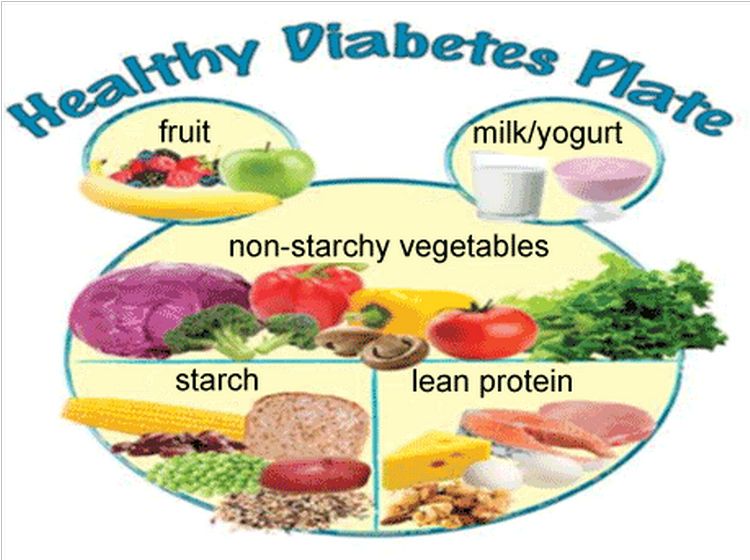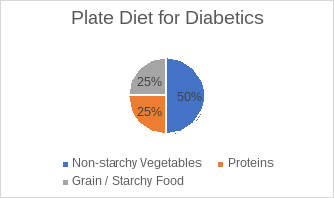In today’s day and age, a healthy diet plays a pivotal role in maintaining not just the physical but also one’s professional and mental wellbeing. This paper delves into the role of diet and exercise in our lifestyle; correction in diet and proper exercise can save you from Diabetes and its complications like cardiovascular disorders, diabetic neuropathy, retinopathy, gangrene, keto-acidosis etc. This Plate Diet is useful in patients with borderline diabetes and also in severe cases of Diabetes Mellitus.
What is a Plate Diet? Don’t worry; your plate won’t be empty, it’s a full plate meal plan. First let us understand the basic definition of high blood sugar levels. Blood Sugar refers to presence of glucose molecules in your blood stream. When there is increase of glucose molecules in your blood stream beyond a particular limit then it’s called Diabetes mellitus.
Type 2 Diabetes is usually associated with hereditary, sedentary lifestyle and wrong diet. Diet plan in Diabetes doesn’t mean that one needs to avoid sweets completely. The American Diabetes Association (ADA) offers a simple Plate Diet Plan for Diabetes. In this plate method there is more focus on vegetables and the portion in which one should eat irrespective of calorie intake. This plate method should be followed for both lunch and dinner. Regular balanced diet helps to keep Diabetes under control. Also eating in small portions in regular intervals helps in proper check and control of Diabetes. This is usually checked by Glycemic index which is rated from 1 to 100. High GI foods are digested and absorbed more quickly. They have a bigger impact on your blood sugar, and you’ll get hungry sooner. Here are some examples:
- High GI: Bread (white and wheat), mashed potatoes, watermelon, fruit juice
- Low GI: Beans, brown rice, tomatoes, yogurt, apples, milk
Our body needs a balanced proportion of carbohydrates, proteins, fats, and fibre. The Plate method introduced by ADA helps in guiding the proper ratio in which food should be consumed. Also, daily brisk walk or exercise for half an hour is beneficial in improving the metabolism of the body. So basically, our motto is to reduce body weight, which in turn controls blood pressure, diabetes, hypercholestremia. Our diet must consist of balanced nutrients which has more of proteins and less of fats and carbohydrates.
The Plate Method Diet is as follows:
- Fill one half of the plate with non-starchy vegetables, such as salad, green beans, broccoli, cauliflower, cabbage, carrots, asparagus, greens (lettuce, spinach, kale, arugula), mushrooms, peppers, snap peas, snow peas, squash (spaghetti squash, zucchini), tomatoes or turnips.
- Fill one quarter with a lean protein, such as chicken, turkey, beans, tofu, or eggs.
- Fill the last quarter with a grain like brown rice, barley, oatmeal, corn or starchy food such as potatoes or pasta (or skip the starch altogether and increase the non-starchy veggies).
- Add a serving of a fruit or unsweetened tea or coffee or dairy. Fruits beneficial in controlling Diabetes: Grapefruit, Java Plum (Jamun). Also avoid canned processed food and beverages/aerated drinks.
One should have 3 meals a day, if intervals are longer than 4 to 5 hours then include snacks in small portions in between.
Eat more fiber:
- Increase the intake of fiber – aim for 21 to 38 grams per day.
- Fiber is found in whole grain breads and cereals, fruits and vegetables, and dried beans and peas
- Increase fiber intake gradually and drink plenty of fluids
Be more active:
- Increase lifestyle activity – use stairs, park further away
- Aim for an hour per day of some or the other kind of regular activity e.g., brisk walking, swimming, skipping, cycling, dancing
- It’s ideal to use a digital device to measure your daily walking activity and the target should be to clock at least 11,000 steps a day
Maintain a healthy body weight:
- If overweight, aim for a moderate weight loss of 5 – 10 % of current weight with gradual reduction to reach ideal BMI
- Choose healthy foods; watch portion sizes and limit sugary drinks
Control your carbohydrate intake:
- Control total carbohydrate intake, not just sugar
- Carbohydrate includes starches and sugars and both make your sugar levels go up.
Pathophysiology:
After you eat, your pancreas releases insulin, a hormone that transports the glucose molecules from your blood into your cells (like those in nerves or muscles) to fuel them. Ideally, you want to keep blood sugar from spiking or plunging to maintain steady energy throughout the day. Your blood sugar naturally rises in response to the food you eat. But it may spike if you eat something highly refined or really sugary. Let’s say you sit at your desk and munch on some candy. Typically, your pancreas will release the necessary amount of insulin, which will push that sugar into cells and bring your blood sugar back down. However, a glucose spike and resulting crash can make you feel sluggish and irritable, giving you brain fog and driving cravings.
Be choosy of Fat Intake:
Avoid saturated fatty foods which cause more harm to your body. Choose foods that are low in saturated fat, trans fat, and cholesterol.
Watch the amount of fat you add to foods such as margarine, mayonnaise, salad dressing or gravy. Use low fat cooking methods such as broiling, baking, steaming or grilling. Avoid deep frying methods.
Omega 3 fatty acids are good source of fats which prevent heart diseases. It increases the HDL levels in blood and decreases the LDL and VLDL levels of cholesterol which are not good for the body. These are present in salmon, flaxseeds. Also avoid eating nuts in any form, fried fatty foods, white bread, white flour, cakes, puddings etc.
Healthy eating habits are a must for leading a healthy lifestyle. Also, Yoga and meditation helps to a certain extend. Daily brisk walks are essential for keeping a control over sugar levels.
So, in short what we must be able to achieve in our diet plan!!!!
- Lower in calories
- Higher in complex carbohydrates found in vegetables, fruits, beans, and whole grain cereals
- Lower in saturated fats like butter, cheese, and fatty meat
- Higher in mono and polyunsaturated fat like olive oil or canola oil
Foods and drinks to avoid include:
- Fried foods and other foods high in trans fat and saturated fat
- Foods high in salt, also called high sodium
- Sweets, such as baked goods, candies and ice cream
- Beverages with added sugars, such as juice, regular soda, and regular energy or sports drinks
Drink water instead of sweetened beverages. Consider using a sugar substitute in your coffee or tea. Stevia would be a good alternative.
If you drink alcohol, drink moderately—no more than one drink (30 ml) / a glass of wine a day if you’re a woman or two a day if you’re a man. When you use insulin or diabetes medicines that increase the amount of insulin your body makes, alcohol can make your blood glucose level drop too low. This is especially true considering you haven’t eaten in a while. It’s best to eat some food when you drink alcohol. Also avoid smoking.
Best wishes for a healthy and happy life.








1 thought on “Plate Diet For Diabetes”